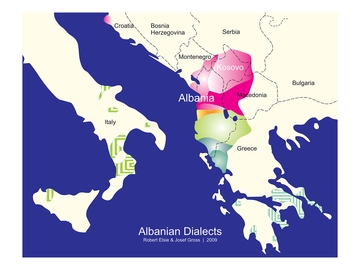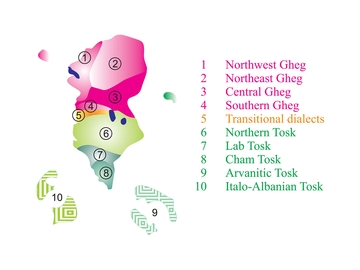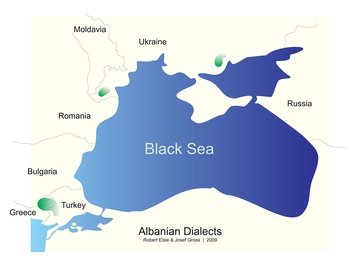
| Robert Elsie | AL Art | AL History | AL Language | AL Literature | AL Photography | Contact |

Albanian Dialects | Introduction
Deutsch | Shqip This website offers the listener audio recordings in Albanian from various regions where the language is spoken. Though the dialects of Albanian are usually mutually intelligible to the listener with an ear for language, regional differences, deriving largely from the historical development of the language, can be substantial, and they are quite fascinating. You can thus listen here to people speaking in a wide range of Albanian dialects. Some of these individuals are good dialect speakers, others were recorded at random to give an idea of how modern Albanian is used in various areas. There are two basic, universally accepted dialect forms of modern Albanian: northern Albanian or Gheg, that is spoken north of the Shkumbin river flowing through Elbasan in central Albania, and southern Albanian or Tosk, that is spoken south of the Shkumbin river. Unfortunately, there is no full agreement on any further dialect classification, though leading dialectologists, such as Jorgji Gjinari and Gjovalin Shkurtaj (b. 1943), Agnija Desnickaja (1912-1992), Shaban Demiraj (1920-2014) and Bahri Beci (b. 1936), have come up with largely similar schemes. Based on these earlier studies, we propose here what we regard as a pragmatic and largely accurate classification system for Albanian dialects, although the reader should keep in mind that for many local dialects, the definitive word on the subject has yet to be written. My thanks go to the many people who have helped me, or at least had patience with me, in this project. Among them are a good number of simple Albanian farmers and shepherds who were bemused and bewildered when a strange foreigner came up to them and wanted to capture and record their speech for no apparent reason. It is to be hoped that the resulting collection of recordings will be of particular use not only to dialectologists, but to everyone with an interest in the Albanian language.GHEG DIALECT
Spoken in most of Albania north of the Shkumbin river, as well as in Kosovo, Montenegro, Serbia, most of the western part of the Republic of Macedonia, and Arbanasi near Zadar in Croatia.Northern Gheg subdialect
Spoken in most Albanian-speaking regions north of the Mat river. These include Ulqin [Ulcinj], Kraja and Podgorica in Montenegro, the Shkodra region, Lezha, Malësia e Madhe, Dukagjin, Puka, Mirdita, Plava, Malësia e Gjakovës, Luma, Has, Kosovo and Presheva [Preševo]. Western variant: Spoken in regions to the west of a vertical line from the Montenegrin-Albanian border initially down the boundary between the Prefecture of Shkodra and the Prefecture of Kukës, including Theth and Shala in Dukagjin and areas west thereof such as Shkodra, Lezha, Malësia e Madhe and Montenegro. Eastern variant: Spoken in regions to the east of a vertical line from the Montenegrin-Albanian border initially down the boundary between the Prefecture of Shkodra and the Prefecture of Kukës, including Nikaj-Merturi and Puka, and areas east thereof such as Gashi, Tropoja, Malësia e Gjakovës, Has, Kukës, Kosovo and Presheva.Southern Gheg subdialect
Spoken in northern central Albania south of the Mat river and north of the Shkumbin river, including Mat, Lura, Peshkopia and most of western Macedonia (Dibra to Skopje and Kumanova), as well as Kruja, Tirana and Elbasan. Central variant: Spoken in the interior basin of the Mat river, extending eastwards to and beyond the Black Drin river, including Mat, part of Mirdita, Lura, Luma, Peshkopia and western Macedonia (the left bank of the Black Drin around Struga, Dibra, Kërçova [Kičevo], Tetova, Gostivar, Skopje and Kumanova), as well as Kruja and Fushë Kruja. Southern variant: Spoken in most of the coastal region from the mouth of the Mat or Ishëm rivers to the mouth of the Shkumbin river, including Durrës, Tirana, and Kavaja, as well as inland areas such as the Tirana mountain range, Martanesh and Çermenika, Elbasan and the valley of the Shkumbin river.TRANSITIONAL FORMS
Spoken in a ten to twenty kilometre horizontal belt along the Shkumbin river valley, mostly on the left (south) side of the river, including the northern Myzeqe plain, Dumreja, Shpat, Polis and Qukës.TOSK DIALECT
Spoken in most of Albania south of the Shkumbin river and into Greece, as well as in the traditional Albanian diaspora settlements in Italy, Greece, Bulgaria and the Ukraine.Northern Tosk subdialect
Spoken in most of Albania south of the Shkumbin river, with the exception of southern coastal areas on the left (southwestern) side of the Vjosa river. On the coast, the southern border of this area is just south of the town of Vlora. Western variant: Spoken in the regions of Myzeqeja, Mallakastra, Berat, Fier, Skrapar, Tepelena on right (eastern) side of Vjosa, Përmet and Vlora, including the area to the north and northeast of the town of Vlora. Eastern variant: Spoken in the regions of Pogradec, Korça, Kolonja and Devoll, as well as the southwestern part of the Republic of Macedonia (the right bank of the Black Drin around Struga, Ohrid, Prespa and Monastir [Bitola]).Southern Tosk subdialect
Spoken in coastal regions south of the town of Vlora and extending down into Greece. Lab variant: Spoken in the Laberia region, being Kurvelesh and Himara down to the Shalës and Pavlle rivers, including Delvina and Gjirokastra. Cham variant: Spoken in the Albanian part of the Chameria [Çamëria] region south of Shalës and Pavlle rivers, and in the Greek part of Chameria sporadically down to Preveza.Arvanitic Tosk subdialect
Spoken traditionally in about 300 villages of central Greece, in particular in Attica, Boeotia, southern Euboia, the northeastern Peloponnese around Corinth, the islands of the Sardonic Gulf, including Salamis, northern Andros, as well as some other parts of the Peloponnese and Phthiotis. This archaic dialect is moribund, though there may still be from 50,000 to 250,000 speakers, mostly older people.Italo-Albanian Tosk subdialect
This archaic variant of Albanian is spoken by about 90,000 people in southern Italy. Speakers are to be found, usually in remote mountain villages, in the regions of Calabria, Molise, Puglia, Basilicata, Campagnia, Abruzzi and Sicily.


AL Dialects
Introduction












